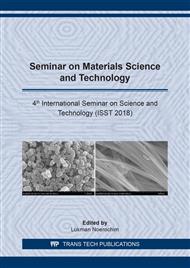p.19
p.26
p.33
p.40
p.45
p.50
p.55
p.62
p.68
The Effects of Nickel Doping on the Structure of LiNixFe1-xPO4/C Cathode Material
Abstract:
This study has been successfully synthesized Nickel (Ni)-doped olivine-type LiNixFe1-xPO4/C with x= 0, 0.01, 0.02, 0.03 as cathode materials, using the solid-state reaction method was in order to investigate the effect on the structure and morphology. The precursor material of ion Ferro (Fe) is used natural material from ironstone of Tanah Laut Kalimantan Indonesian which combined with proanalis materials. The X-Ray Diffraction (XRD) patterns on the structure magnetite iron have shown that single phase of Fe3O4 and the patterns of structure LiNixFe1-xPO4/C indicated that doping Ni2+ have shown the orthorhombic structure with space group Pnma for all LiNixFe1-xPO4/C samples. Base on Rietveld method by Rietica software, the formation of phase resulted in olivine structure except at the concentration x = 0.02 and 0.03 have a second phase, that is nasicon structure with a smaller percentage than olivine structure. The general condition, coating carbon on LiNixFe1-xPO4/C particles by solid state reaction can be perfect which demonstrate the homogeneous existence of carbon on the surface of LiNixFe1-xPO4/C particles shown by images Scanning Electron Microscopy (SEM). The increased doping of Ni ions causing the Fe ions to decrease base on Energy Dispersive X-Ray Spectroscopy (EDS) observations.
Info:
Periodical:
Pages:
45-49
Citation:
Online since:
July 2019
Authors:
Price:
Сopyright:
© 2019 Trans Tech Publications Ltd. All Rights Reserved
Share:
Citation:


